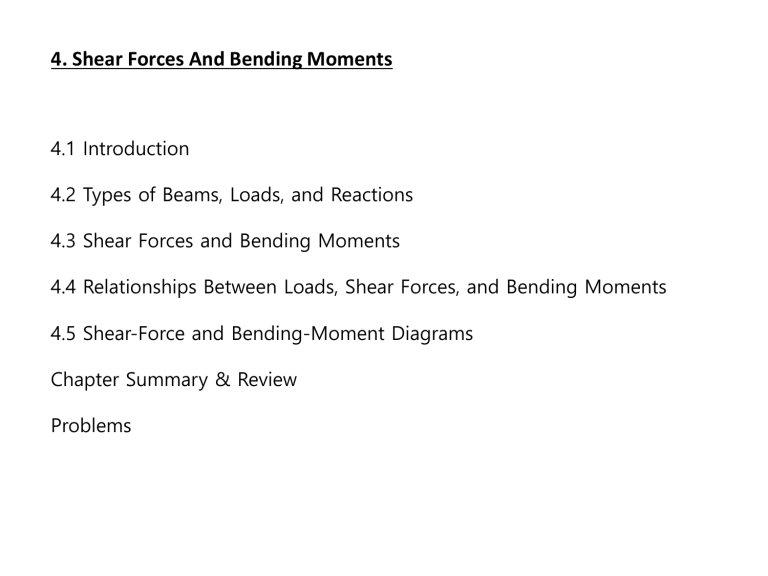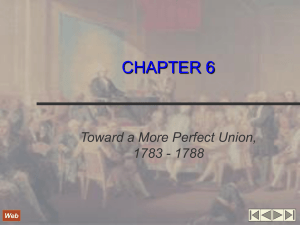
4. Shear Forces And Bending Moments 4.1 Introduction 4.2 Types of Beams, Loads, and Reactions 4.3 Shear Forces and Bending Moments 4.4 Relationships Between Loads, Shear Forces, and Bending Moments 4.5 Shear-Force and Bending-Moment Diagrams Chapter Summary & Review Problems © 2001 Brooks/Cole, a division of Thomson Learning, Inc. Thomson Learning™ is a trademark used herein under license. 4.4 Relationships Between Loads, Shear Force, and Bending Moment Fig. 4-10 Element of a beam used in deriving the relationships between loads, shear forces and bending moments (all loads and stress resultants are shown in their positive directions.) ■ Distributed Load(Fig 4-10(a)) Shear Force. Equilibrium of forces in the vertical direction (upward forces are positive) gives as follows. , (4-4) the rate of change of the shear force = the negative of the intensity of the distributed load if there is no distributed load If q=0 , then if the distributed load is uniform If q=constant , then = constant and shear force changes linearly in that part of the beam. Fig. 4-8 Example 4-2. Shear force and bending moment in a cantilever beam. © 2001 Brooks/Cole, a division of Thomson Learning, Inc. Thomson Learning™ is a trademark used herein under license. ● Example Taking the derivative from gives 𝑑𝑉 = −𝑞 𝑑𝑥 (a) (4-5) = - (Area of the loading diagram between A and B) Bending Moment. Let’s now consider © 2001 Brooks/Cole, a division of Thomson Learning, Inc. Thomson Learning™ is a trademark used herein under license. the moment equilibrium in Fig. 4-10a. Summing moments Discarding products of differentials 𝑑𝑀 =𝑉 𝑑𝑥 the rate of change of the bending moment = the shear force (4-6) ● Example Again using the cantilever beam of Fig.4-8 the bending moment : the derivative : 𝑑𝑀 =𝑉 𝑑𝑥 from Integrating between two points A and B (4-7) =(area of the shear-force diagram between A and B) ■ Concentrated Loads(Fig. 4-10(b)) © 2001 Brooks/Cole, a division of Thomson Learning, Inc. Thomson Learning™ is a trademark used herein under license. Now let’s consider a concentrated load P acting on the beam element(Fig. 4-10(b)) From equilibrium of forces in the vertical direction, we get 𝑉1 = −𝑃 (4-8) the shear force decreases by the magnitude of the downward load P. From equilibrium of moments about the left-hand face of the element(Fig. 4-10(b)), we get Since the length dx of the element is infinitesimally small, the increment M1 is also infinitesimally small. Thus, the bending moment does not change. At the left-hand side the rate of change of the bending moment : 𝑑𝑀 =𝑉 𝑑𝑥 At the right-hand side 𝑑𝑀 = 𝑉 + 𝑉1 = 𝑉 − 𝑃 𝑑𝑥 It can be seen that the concentrated load doesn’t affect the change of moment. © 2001 Brooks/Cole, a division of ■ Loads in the form of couples (Fig.4-10(c)) From equilibrium of the element in the vertical direction : the shear force doesn’t change From equilibrium of moments about the left-hand side of the element gives Disregarding terms that contain differentials (4-9) It can be seen that the bending moment does affect the change of moment. The bending moment changes abruptly by 𝑀0 4.5 Shear-force and bending-moment diagrams Diagrams showing the variation of N,V,M are very useful. Because these diagrams quickly identify locations and values of maximum N, V, M needed for design. © 2001 Brooks/Cole, a division of Thomson Learning, Inc. Thomson Learning™ is a trademark used herein under license. ■ Concentrated loads Fig. 4-11 Shear-force and bending moment diagrams for a simple beam with a concentrated load. with a concentrated load. 1) , (4-10 a, b) ( ) (4-11a,b) ( ) (4-12a) (4-12b) (4-13) from =0 the slope is zero =V the slope is equal to V © 2001 Brooks/Cole, a division of Thomson Learning, Inc. Thomson Learning™ is a trademark used herein under license. The maximum shear forces and bending moments in a beam may occur at the following place s: A cross section where a concentrated loads is applied and the shear force changes sign A cross section where the shear force equals zero. A point of support where a vertical reaction is present A cross section where a couple is applied © 2001 Brooks/Cole, a division of Thomson Learning, Inc. Thomson Learning™ is a trademark used herein under license. ■ Uniform load Fig. 4-12 Shear-force and bending moment diagrams for a simple beam with a uniform load. = = (4-14b) The slope is -q 𝑞𝐿 − 𝑞𝑥 = 𝑉 2 the slope is V The maximum moment occurs where the shear force equals zero. (4-15) © 2001 Brooks/Cole, a division of Thomson Learning, Inc. Thomson Learning™ is a trademark used herein under license. (4-14a) © 2001 Brooks/Cole, a division of Thomson Learning, Inc. Thomson Learning™ is a trademark used herein under license. ■ Several Concentrated loads , ( 0 < 𝑥 < 𝑎1 ) (4-16a b) (𝑎1 < 𝑥 < 𝑎2 ) (4-17a b) Fig. 4-13 Shear-force and bending moment diagrams for a simple beam with several concentrated loads. (4-20a,b,c) (4-18b) (𝑎3 < 𝑥 < 𝐿 ) (4-18b) © 2001 Brooks/Cole, a division of Thomson Learning, Inc. Thomson Learning™ is a trademark used herein under license. © 2001 Brooks/Cole, a division of Thomson Learning, Inc. Thomson Learning™ is a trademark used herein under license. 𝑥 = 𝑎1 , 𝑥 = 𝑎2 , 𝑥 = 𝑎3 (𝑎2 < 𝑥 < 𝑎3 ) © 2001 Brooks/Cole, a division of Thomson Learning, Inc. Thomson Learning™ is a trademark used herein under license. (4-18a) ■ Ex 4-4 © 2001 Brooks/Cole, a division of Thomson Learning, Inc. Thomson Learning™ is a trademark used herein under license. Draw the shear-force and bending-moment diagrams for a simple beam with a uniform load of intensity q acting over part of the span(Fig. 4-14a). Fig. 4-14 Example 4-4. Simple beam with a uniform load over part of the span. © 2001 Brooks/Cole, a division of Thomson Learning, Inc. Thomson Learning™ is a trademark used herein under license. Solution 1) Reaction. 2) ( 0<𝑥<𝑎 ) (4-21a,b) (4-22a,b) ( ( ) ) (4-23a,b) (4-24a,b) 3) maximum bending moment occurs where the shear force equals zero from V = 0 *( ) (4-25) This point can be found by setting the shear force V equal to zero and solving for the value of x1. ☆ Special case : If , © 2001 Brooks/Cole, a division of Thomson Learning, Inc. Thomson Learning™ is a trademark used herein under license. Now we substitute -----> (4-26) from (4-25) and (4-26) (4-27a,b) ■ Example 4-5 © 2001 Brooks/Cole, a division of Thomson Learning, Inc. Thomson Learning™ is a trademark used herein under license. Draw the shear-force and bending-moment diagrams for a cantilever beam with two concentrated loads(Fig. 4-15a) 1) Fig. 4-15 Example 4-5. Cantilever beam with two concentrated loads (a,b) © 2001 Brooks/Cole, a division of Thomson Learning, Inc. Thomson Learning™ is a trademark used herein under license. Solution 2) ( 0 < 𝑥 < 𝑎) (c,d) ( 𝑎 < 𝑥 < 𝐿) (e,f) ■ Example 4-6 A cantilever beam supporting a uniform load of constant intensity q is shown in Fig. 4-16a. © 2001 Brooks/Cole, a division of Thomson Learning, Inc. Thomson Learning™ is a trademark used herein under license. Draw the shear-force and bending-moment diagrams for this beam. Fig. 4-16 Example 4-6. Cantilever beam with a uniform load. (4-28a,b) 2) (4-29a,b) 3) 𝑉𝑚𝑎𝑥 = −𝑞𝐿 © 2001 Brooks/Cole, a division of Thomson Learning, Inc. Thomson Learning™ is a trademark used herein under license. Solution 1) (4-30a,b) ☆¤ (g) (h) ■ Example 4-7 A beam ABC with an overhang at the left-hand end is shown in Fig. 4-17a. The beam is subjected to a uniform load of intensity 𝑞 = 1.0 𝑘/𝑓𝑡 on the overhang AB and a counterclockwise couple 𝑀0 = 12.0 𝑘 − 𝑓𝑡 acting midway between the supports at B and C. © 2001 Brooks/Cole, a division of Thomson Learning, Inc. Thomson Learning™ is a trademark used herein under license. Draw the shear-force and bending-moment diagrams for this beam. Fig. 4-17 Example 4-7. Beam with an overhang. Solution 1) 𝑅𝐵 = 5.25 𝑘 2) 𝑅𝐶 = 1.25 𝑘 𝑞𝑏2 1 𝑀𝐵 = − = (1.0 𝑘/𝑓𝑡)(4.0𝑓𝑡)2 = −8.0 𝑘 ∙ 𝑓𝑡 2 2 The bending moment just to the left of the couple 𝑀0 is −8.0 𝑘 ∙ 𝑓𝑡 + 1.25 𝑘 8.0 𝑓𝑡 = 2.0𝑘 ∙ 𝑓𝑡 The bending moment just to the right of the couple 𝑀0 is 2.0𝑘 ∙ 𝑓𝑡 − 12.0𝑘 ∙ 𝑓𝑡 = −10.0𝑘 ∙ 𝑓𝑡 The bending moment at the support C is as expected. −10.0𝑘 ∙ 𝑓𝑡 + 1.25 𝑘 8.0 𝑓𝑡 = 0






